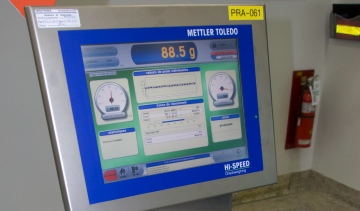
L'Oreal's hair to the throne
By George Guidoni, Editor, Canadian Packaging
Sustainability 3S Packaging Technology ABB Canada Berry Plastics Corporation Cermex Inc. Inc. IWKA Group KUKA Robotics canada L'Oreal Canada Ltd. Markem-Imaje Inc. Mecano Industrie Inc. Mettler-Toldeo inc. North American Laser Systems Inc. Optel Vision PharmaCos Machinery Inc. Rockwell Automation Canada SEW-Eurodrive Co. of Canada Ltd.Leading hair-care products manufacturer combines world-class manufacturing prowess with progressive sustainability practices to cement its marketplace prominence.
Beauty may well be in the eyes of the beholder, as the age-old wisdom suggests, but most beholders will agree that a healthy and well-groomed head of hair is an essential part of that all important, eye-pleasing, long-lasting first impression for men and women alike the world over.
Essential enough, in fact, to support a multibillion-dollar global hair-care industry led by some of the world’s most innovative, technologically pioneering, leading-edge manufacturing enterprises such as the globally-operating beauty products powerhouse L’Oréal Group.
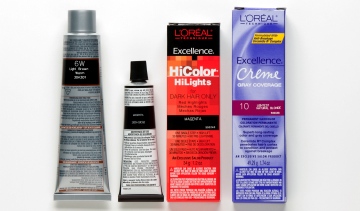
Professional hair-coloring products made and packaged at the Saint-Laurent facility feature detailed, crisp and permanent text and other graphics generated on both the tubes and outside folding cartons by the Canlase laser product marking systems manufactured in Canada by North American Laser Systems Inc.
Headquartered in the Paris suburb of Clichy, Hauts-de-Seine, France, the world’s largest cosmetics and beauty company is in many ways a model example for multinational conglomerates across a broad range of global industries—enjoying virtually unrivaled brand recognition, envious market share and penetration, far-flung geographic reach, and a staggering portfolio of category-leading products that routinely enables the forward-thinking company, founded in 1907 by a young French chemist Eugène Schueller, to generate annual revenues of over $25 billion.
And while the company has reaped rich marketplace rewards over the decades from research-driven product diversification—successfully expanding into the lucrative cosmetics, skin-care, perfumes and sun protection segments of the global H&B (health and-beauty) marketplace—hair products remain very much at the core of a global business colossus that operates 42 manufacturing plants throughout the world, employing over 66,000 people.
Operating out of Montreal since 1968, the L’Oréal Canada subsidiary provides a mirror-like reflection of its parent company’s long-sustained growth in the world’s hair-care industry, in which its founder played a vital pioneering role more than 100 years ago by formulating a breakthrough, long-lasting hair dye formula, which he proceeded to manufacture and sell to Parisian hairdressers under the Auréole brand name.
Starting Out
Originally started up in Hamilton, Ont., in 1958, L’Oréal’s Canadian operations have blossomed over time to become one of its most rewarding offshore ventures—today commanding a leading 25-percent share of the Canadian beauty market and employing over 1,200 Canadians across the country.
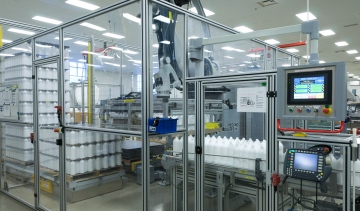
A Kuka robot inside a fully-enclosed, automated depalletizing workcell supplied by Mecano Industrie Inc. unloading rows of empty plastic containers and placing them onto the conveyor belt to be transferred to the filling station.
This includes over 900 people in the province of Quebec—employed at the company’s Montreal area manufacturing plant and distribution center, the stylish Canadian headquarters in downtown Montreal, and out-in-the-field sales force.
Having been expanded, modernized and upgraded 10 times since its start-up 43 years ago, the L’Oréal Canada manufacturing plant in the city’s Saint-Laurent suburb is today a veritable showcase of cutting-edge product innovation and world-class manufacturing and packaging capabilities—empowered with global manufacturing mandates for a broad range of professional products used by hair salons and licensed hairdressers in 39 countries around the world.
Employing about 250 unionized staff on a busy three-shift, five-days-a-week schedule, the highly automated, 322,000-square-foot facility houses a total of 27 high-performance packaging lines and 22 manufacturing/ processing skids to turn out over 150 million individual packaged products a year, according to L’Oréal Canada president and chief executive officer Javier San Juan, making it not only a vitally important supply chain link in the company’s global business, but also a well-respected example of world-class manufacturing efficiency, top-notch product quality, benchmark packaging and distribution excellence, and admirable commitment to corporate social responsibility (CSR).
“L’Oréal Canada has always believed that lasting business success is built on a genuine sense of responsibility to the community at large, and on strong ethical standards which guide our growth,” asserts Spanish-born San Juan—a life-long, globetrotting H&B business veteran who joined L’Oréal Canada in 1998 after a succession of senior management postings around L’Oréal’s global empire, including Russia, Romania, Thailand, Argentina and Uruguay, among others.
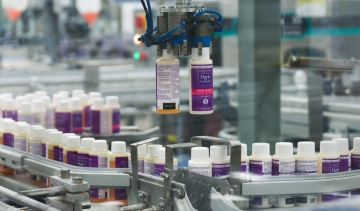
A close-up view of the end-of-arm tooling on the IRB 120 model robot from ABB gently manipulating filled bottles of product to place them precisely in their proper spots on the fast-moving conveying line directly below.
For all his exotic world travel, San Juan says he has developed a heartfelt fondness and affinity for Canada since his arrival, taking special personal pride in the fact that his third daughter was born in Canada a few years back.
“Personally I think that Canada is an exotic country in itself,” San Juan told Canadian Packaging in a recent interview. “It is such a richly complex society, combining so many different nationalities, that I realized very early on that it would be a very refreshing challenge for me here, both professionally and personally.
“It is always a challenge, of course, for any European company to come to North America and take on some of the U.S.-based mega-competitors on their home turf, but I think we are doing quite well,” says San Juan, citing L’Oréal Canada’s annual sales of over $800 million that rank that company as one of Canada’s top ten corporations.
Adds San Juan: “I think that Canadian consumers are very well-educated and open-minded in large part because of the multinational diversity in the Canadian culture, and such diversity is really part of the DNA for a company like L’Oréal.
“Our manufacturing plant alone employs people of 17 different nationalities, speaking a lot of different languages,” states San Juan, “and I feel such diversity plays an important role in how well received L’Oréal products have been by Canadian consumers in the marketplace.”
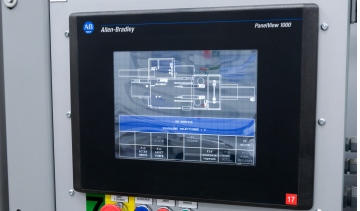
The Allen-Bradley range of user-friendly, touchscreen operator panels manufactured by Rockwell Automation (above) are a common sight throughout the highly automated Saint-Laurent manufacturing facility, including this PanelView 1000 model terminal used to control and operate Cermex case-packing equipment.
Turning out approximately 2,200 SKU (stock keeping units) in over 150 different packaging formats ranging from tubes to pouches and sachets, the Saint-Laurent plant is considered to be one of the most productive L’Oréal production facilities worldwide, according to vice-president of industry Jean-Victor Pycke, exporting about 95 per cent of its output, including the all-important U.S. market.
Quality First
With near-perfect product quality levels in excess of 99.9 per cent, the plant has little trouble securing new manufacturing mandates from its parent company, relates Pycke, citing the 2007 facility expansion and capital equipment investment necessitated by receiving a world mandate for production of the SoftSheen•Carson product line—adding to other bestselling professional brands, produced in liquid and/or cream formulations, such as L’Oréal Professionnel, Matrix, Redken and Garnier.
“The Saint-Laurent plant is continuously upgrading and expanding in order to meet with the many different mandates it receives,” says Pycke.
“Just recently, we were asked to ramp up production to begin manufacturing L’Oréal’s INOA solution, which is the first ammonia-free professional hair-coloring product on the market,” says Pycke, relating how extra production demands prompted installation of an IRB 120 series packaging robot from ABB to work within a custom-designed, explosion-proof tube filler because of alcohol content in the product’s formulation.
Due to the volatile nature of the hair-coloring products, workplace safety and sanitation are paramount priorities, Pycke explains, which in turn requires the multi-certified plant to continually invest in automation technologies, such as robots, to minimize manual product handling.
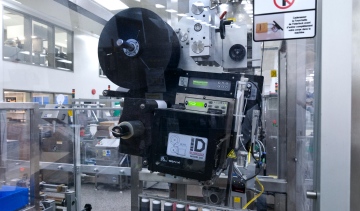
A Model 250 labeling application system from ID Technology makes quick work of attaching barcoded product labels onto the sides of passing corrugated boxes making way to the end-of-line packaging area.
“It has to be a very highly-automated facility,” states Pycke, pointing out that most of the packaging lines are usually staffed by just one operator—mostly monitoring that all of the automated, computerized production and packaging systems are running as they should.
Boasting top-level triple international certification with ISO 9001 quality management systems, ISO 14001 environmental management and OSHAS 18001 workplace safety registrations, the Saint-Laurent plant enjoys a solid safety record and good labor relations with its workforce, represented by the Teamsters union.
“First and foremost, we need to ensure the safety of our employees,” states Pycke, “because having a very active and engaged workforce allows us to achieve our targets.
“The employees’ active participation in working groups ensures that our EH&S (safety, hygiene and environment), quality and productivity targets are consistently met,” relates Pycke, citing numerous awards received by the plant over the years “for exemplary performance” from the L’Oréal Group in the internal annual evaluation of its plants, administrative sites and distribution centers worldwide.
“The cosmetics industry is a very fast-paced and competitive industry,” he remarks, “so having a dedicated, highly-skilled and engaged workforce is key to our success, as well as being able to produce innovative, high-quality products that meet the needs of our customers and consumers worldwide.”
Adds San Juan: “We have been using a very innovative approach to ensure safe handling of loads, which has led to a significant improvement in the factory’s job-related injury rates.
“We had managers of all levels trained to provide on-the-spot, one-on-one coaching in safety, which combined with simple but powerful risk reduction tools has dramatically raised the awareness of safety issues among employees—resulting in very high safety standards,” he points out.
To retain its edge in human resources, the company uses progressive hiring practices and provides attractive incentives to draw the best and the brightest, points out San Juan, across all of its Canadian operations.
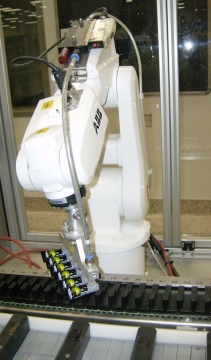
Installed at the Saint-Laurent manufacturing facility in April of 2010 to accommodate additional production volumes for the recently-launched INOA line of ammonia-free permanent hair-coloring solutions, this ABB model IRB 120 robot was integrated into a fully-automated, explosion-proof workcell by the Montreal-based packaging equipment turnkey systems specialists PharmaCos Machinery Inc. to work in tandem with a Kalix cartoner system by utilizing an Allen-Bradley programmable logic controller (PLC).
“In Canada we continuously recruit dynamic talent for some of the most exciting careers in the beauty industry,” says Juan, pointing out the company’s deep commitments to strong R&D (research-and-development) activities, on which it spends about four percent of its annual turnover.
“We openly encourage individuality and risk taking, appreciate creativity and innovation, and offer an environment of ongoing learning and personal growth because it is essential for us to remain a highly-innovative manufacturer in what is a fiercely competitive business.”
Adds Pycke: “Working for L’Oréal is considered to be a very prestigious career choice in the Montreal area: the company has a very good reputation for both its work environment and for strong bonds with the local community.
“Our employees take a lot of pride in their jobs,” he states, “wherever they work in the company.”
This certainly applies to the Saint-Laurent plant’s “very important packaging department,” relates Pycke, which employs about 100 people to execute packaging-related functions at the facility, including line operators, line mechanics and forklift drivers.
“Due to the nature of our products we do have a lot of special packaging requirements, such as explosion-proof fillers,” says Pycke, “and while we try to use local suppliers for our packaging materials and machinery requirements, what is most important to us at the end of the day is the quality of their products.”
Pycke says the plant boasts a diverse selection of top-quality, high-performance packaging equipment such as fillers, labelers, cartoners, unscramblers, automated palletizers, shrinkwappers and casepackers, singling out industrial robotics supplier ABB Canada, packaging systems integrator Pharmacos Machinery Inc., and product coding systems developer North American Laser Systems Inc. as some of the plant’s foremost “long-standing partners” in Canada.
Also located in Saint-Laurent, the company’s 250-employee distribution center is a high-throughput, high-tech 322,000-square-foot facility operating on a two-shift, five-day-week schedule to ship L’Oréal Canada’s complete brand portfolio to more than 8,000 points-of-sale across Canada—including all major drug-store chains and other retailers—with flawless on-time delivery, according to the DC’s vice-president of operations Pierre Massicotte.
Big Boost
Originally started up in 2001, the “beautiful and ultra-modern building” can easily boost its throughput capacity to accommodate seasonal peaks in the summer to handle extra volume of sun-care products, Massicotte relates, as well as for special holidays like Christmas and Mother’s Day.
“Everything involved in L’Oréal Canada’s supply chain management of all of our brands is housed under one roof at this DC,” says Massicotte, citing an extensive list of popular consumer brands such as L’Oréal Paris, Garnier, Maybelline New York, Ombrelle, Lancôme, Biotherm, Giorgio Armani, Ralph Lauren, Kiehl’s Since 1851, Victor & Rolf, Laboratoires Vichy, La Roche-Posay Laboratoire Pharmaceutique, The Body Shop, Yves Saint-Laurent Beauté, Roger & Gallet, Stella McCartney and Ermenegildo Zegna.
Also responsible for shipping all the online orders for North America received through its website for the Biotherm skin-care products and Shu Uemura cosmetics lines, the DC facility expedited over 500,000 orders in 2010, according to Massicotte, representing more than 100 million product units.
“The distribution center is continuously upgrading its equipment and systems in order to better meet its needs,” Massicotte relates, citing recent installations of mobile ‘shoppeur’ carts equipped with barcode reading ‘pickers,’ as well as the installation of pallet flow and span tracks in the racks to maximize the stocking space vertically in each location.
‘“We also completely redesigned the ‘pedestrian aisle’ in order to ensure the safest possible environment for the employees—most of the aisle has physical protection that separates the flux of motorized equipment and the pedestrian (on foot) staff,” he adds.
Like with the manufacturing plant, the relentless focus on quality provides an essential competitive imperative for the DC, says Massicotte, citing picking accuracy rates of over 99.95 per cent.

A model Imaje 4040 inkjet case-coding system from Markem-Imaje applying large-character text, logos and barcodes to loaded corrugated shipping boxes making their way to the palletizing station just up ahead.
“Our people are well-trained in all aspects of quality control and assurance, and we supply them with all the tools that they need to keep up our quality standards and meet all our picking, shipping and delivery targets,” says Massicotte, adding the DC operates robust WMS (warehouse management system) and other enterprise management software from SAP to make the operation run like clockwork. As one of Montreal’s biggest and most high-profile industrial employers, L’Oréal Canada takes its community relations very seriously.
“We are deeply committed to positioning L’Oréal Canada amongst the most exemplary Canadian corporations of the 21st century in the field of sustainable development,” San Juan asserts.
“And by constant product innovation, improved efficacy, and by following the highest standards of product safety and responsible advertising, we are determined to make L’Oréal Canada a leader in corporate consumer responsibility,” he states, citing proactive communal efforts of the L’Oréal Corporate Foundation as one of many examples of the company’s model corporate citizenship.
Formed in 2007, the foundation actively pursues three main noble causes, San Juan relates, including:
• Promoting scientific research and the role of women in science through the L’Oréal-UNESCO For Women in Science program;
• Helping people feeling vulnerable because of a change in their appearance to regain their self-esteem and self-confidence through the Look Good, Feel Better program;
• Facilitating access to education through the Hairdressers against Aids program.
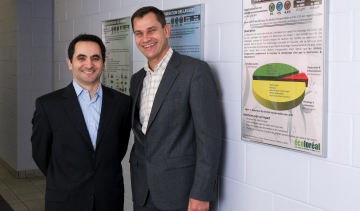
L’Oréal Canada’s director of procurement and development David Ohayon (left) and vice-president of industry Jean-Victor Pycke pose in front of posters providing progress updates on the company’s Réduction à la source inhouse waste diversion program, recently awarded formal recognition by the Quebec government’s Recyc-Quebec agency that oversees all recycling and waste reduction activities in the province.
“Also, in 2009 L’Oréal Canada launched an innovative program to fight high-school drop out rates,” San Juan relates. “We implemented a theater program in a school located in an underprivileged section of Montreal with the goal of encouraging students to stay in school by actively engaging them in all aspects of the play: acting, set design, accessories, etc.
“We have had terrific response.”
Adds Pycke: “The L’Oréal Canada manufacturing plant and distribution center are an integral part of the Saint-Laurent community and are actively involved in several programs organized by the borough, such as incentives for employee car-pooling and ‘vélo-boulot (bike-to-work) programs, and the tree-planting project for the borough of Saint-Laurent’s industrial and commercial park—with the aim of reducing the amount of greenhouse gas emissions in the borough generated by the industrial park.”
Reducing the company’s manufacturing carbon footprint is an ongoing corporate priority and objective of “great importance” for L’Oréal Canada, according San Juan.
“We are committed to implementing an environmentally-responsible approach in managing our operations and always aim for excellence in executing it,” he states, listing three core waste reduction targets to be achieved by the Saint-Laurent plant and DC facility by 2015, compared to 2005 levels:
• Reducing greenhouse gas emissions by 50 per cent;
• Reducing its water use per unit of finished product by 50 per cent;
• Reducing the waste generated per unit of finished product by 50 per cent.
“This approach plays a key role at every step of the production chain and testifies to L’Oréal Canada’s determination to respond to growing consumer expectations,” says San Juan, proudly citing the company’s recent inclusion on the prestigious World’s 100 Most Sustainable Corporations list of the Corporate Knights Magazine, along with the Top 50 Socially Responsible Corporations by the Canada’s leading national weekly publication Maclean’s of Rogers Media.
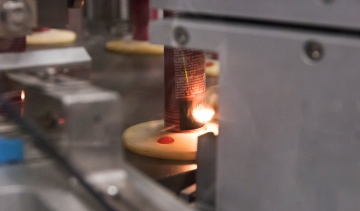
Close-up view of one of a couple of dozen made-in-Canada Canlase laser-coding product marking systems supplied to the Saint-Laurent plant by North American Laser Systems to accommodate the operation’s switch to laser technologies from inkjet coders.
“Values such as integrity, responsibility and respect for people and the environment have been a key part of L’Oréal’s DNA since the early days,” stresses San Juan, “and it is very gratifying to see our commitment to sustainable growth bringing us recognition as one of the world’s most sustainable businesses. We are fully committed to the development, production, distribution and sale of innovative, high-quality products in an ethical manner by minimizing our impact on the environment and guaranteeing the safety of our employees and consumers.”
Naturally, using more sustainable packaging products and practices plays a vital role in the company’s greater sustainability vision, San Juan relates.
“We have many examples of ongoing ‘green’ improvements when it comes to our packaging—from printing instructions directly on the packaging, rather than inserting a leaf let inside the box, to using laser labelers on the packaging instead of printing labels, to maximizing the space used in the delivery trucks in order to save on transport costs and CO2 emissions,” San Juan confides.
“We have also been working very closely with our component and raw material suppliers to reduce the packaging where possible—either by going to larger formats, such as big bags, or by eliminating the packaging all together, by doing things like stacking filled bottles directly onto a pallet,” he expands.
Shuttle Service
“Moreover, the increased use of shuttle packaging allows us to reuse the same packaging up to 30 times when delivering products to the customer sites,” San Juan remarks, “which in turns reduces our transportable waste.
“We are very proud of the fact that most of the production lines at our DC facility are now waste-free because we can now reuse the suppliers’ boxes and protective foam to fill our own orders.
“As an industry leader we constantly look for ways to partner and share best practices with our stakeholders,” he adds. “We participate in numerous important industry groups and associations such as GS1 Canada, with its goal of bringing together manufacturers, retailers and other partners in a collective effort to develop industry standards in the area of sustainable packaging.”
According to San Juan and Pycke, switching the product marking and coding operations at the plant several years ago from inkjet printers to laser-based product marking technologies—these days supplied exclusively by the Mississauga, Ont.-based North American Laser Systems Inc.—has played a significant role in reducing the Saint-Laurent facility’s packaging footprint, while also delivering higher print quality, operational savings and much lower maintenance requirements.
“This was a very profound positive change for our operations,” Pycke remarks, praising the reliability and ease-of-operation of the Canlase laser coders employed throughout the facility to permanently mark and code not only the aluminum and plastic tubes inside the automated filling stations, but also to mark up the secondary packaging, primarily folding cartons, with all the essential product data further down the line.
“Not only have we achieved significant cost savings by eliminating the use of certain packaging materials such as labels,” he says, “we are eliminating a lot of ink and other consumables that could otherwise end up in landfills or out in the environment.
“We are very happy and comfortable with using laser coders in our operations,” he says, “and we are glad this is one of those key technologies for our business that we can obtain from a Canadian supplier.”
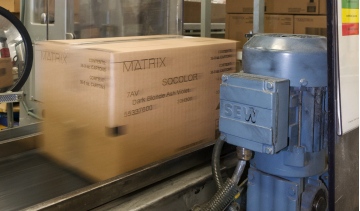
Heavy-duty SEW-Eurodrive motors power conveyor belts transporting corrugated shipping boxes to the palletizing area.
That’s naturally music to the ears of North American Laser Systems general manager Greg Griffin, who estimates to have supplied 24 Canlase coders to the Saint-Laurent plant over the last several years.
“They usually buy a couple of systems a year from us as their production requirements grow,” says Griffin, saying each Canlase system shipped to L’Oréal is entirely custom-assembled and tested in Mississauga to full specs before it is installed inline at the plant.
“We do sell some off-the-shelf products, but for majority of our industrial clients our custom design capabilities are almost as important as the systems’ reliability and quality,” says Griffin, also citing the likes of Colgate-Palmolive, General Motors and Magna as some of his company’s more illustrious blue-chip clients.
“The thing that makes laser coders so reliable, compared to inkjet technology, is the fact that there are so few moving parts,” he states.
“You only have two mirrors and the carbon laser itself, so the machine maintenance requirements are virtually nonexistent,” he says, adding that the Canlase coding systems are outfitted with all the required HEPA filters and vacuum-packed fume extractors to capture all emissions right at the source.
“They have been a very good supplier partner for us to work with,” states Pycke, agreeing that the laser-based product marking method provides for far superior, virtually defect-free print quality than anything that inkjet systems could rival, especially when working with such hard-to-mark packaging as aluminum tubes.
Other important sustainability initiatives carried out in recent years by L’Oréal Canada include impressive energy conservation and water use reductions through heat recovery, lighting systems upgrades and other like-minded, well-executed process improvements.
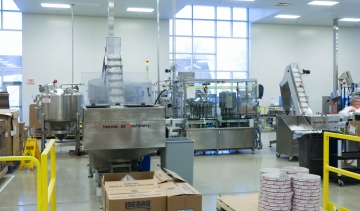
Custom-designed automated unscramblers integrated by PharmaCos Machinery are used to begin the transfer of empty plastic jars and containers, supplied in bulk by Berry Plastics Corporation, to the plant’s packaging lines via bucket elevators.
“We are committed to reducing our environmental impact and resource use through ‘absolute reductions,’ as we call it,” San Juan states. “Where this is not practicable, we always aim for greater eco-efficiency and use of environmentally friendly approaches.
“The specific measures can include simple things like modernizing the lighting in our distribution center and manufacturing plant,” he expands. “To date, we have changed over 1,200 high-pressure sodium fixtures and replaced them with more efficient fluorescent ones, while automating both HVAC (heating, ventilation and air-conditioning) systems.
“This specific initiative alone resulted in a 26-percent decrease in electricity use at the DC and a five percent reduction for the manufacturing plant.
“In addition, we all now enjoy the ergonomic benefits that came with this change,” he reflects. “Fluorescent lighting is much closer in terms of color to natural light and as a result, the work environment is more pleasant than before, and the employees are feeling less tired by the end of the day.”
In a similar vein, the DC facility has also achieved significant cuts in the consumption of natural gas used to heat the building.
“The entire ventilation system there was recently reviewed, centralized and enhanced with various new types of controls, including a building pressure probe to ensure constant positive pressure across the site, humidity probes and CO2 detection probes,” relates San Juan. “The idea was to optimize, or rather minimize, the entry of fresh air into the building, which needs to be heated in the winter.
“We estimate we have realized a 35-percent reduction in CO2 emissions with this project,” states San Juan, adding the DC is currently completing an installation of an entire solar-panel wall to heat warehouse spaces throughout the building.
“We have also implemented measures to recover the heat from our wastewater in order to warm up the warehouse,” he notes. “This has reduced our natural gas consumption at the plant by 20 per cent in 2010, while eliminated over 500 tonnes of CO2 emissions annually.
As for the company’s recycling and waste diversion efforts, San Juan says he takes great personal pride in Ici on Recycle – level 3 certification awarded to the plant in 2009 and the DC building in 2011—the highest recognition of environmental excellence bestowed by the provincial Recyc-Quebec agency—along with Recyc-Quebec’s Special Mention honors for the plant’s inhouse Réduction à la source project this past February.
All in all, San Juan says he expects the next few years to be “very exciting” for L’Oréal Canada, its customers, and the consumer public at large.
“I am very proud that Canada, with its relatively small population of 33 million, ranks as one of the top ten markets for L’Oreal worldwide,” he states. “We are the Number One cosmetics company in Canada, with our 25 brands competing in all the beauty industry channels—from the mass market to the luxury market, to the dermatologist-recommended brands found in drugstores, to spa specialty brands, to products used and sold in beauty salons across the country.
“It is an impressive achievement to be shared by all our employees,” he adds, “and you can be sure that high-quality, sustainable packaging will continue to remain of utmost importance to us.
“We feel that packaging can in fact be used to guide consumers in their eco-friendly gestures,” he points out, singling out product disposal instructions such as, ‘Do not rinse out this bottle before throwing it in the recycling bin: it will waste water,’ messaging on the packages, “as well as a vital tool for growing our brand loyalty in Canada even further.
“Our packaging is generally the first and last point of contact that the consumer has with our brands,” San Juan concludes, “which makes it an integral part of our marketing mix and a key driver in helping us forge stronger links with Canadian consumers well into the future.”
Advertisement


